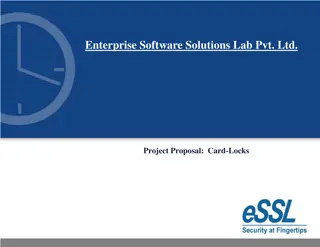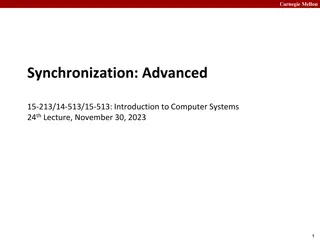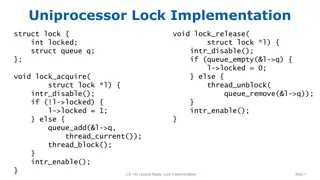Semaphores and Locks for
This content delves into the essential concepts of semaphores, locks, and synchronization in operating systems, emphasizing the importance of proper implementation for optimal performance. It discusses the use of locks, semaphores, mutexes, and object locking to manage shared resources efficiently, as well as the considerations for preventing concurrency issues. Key topics include basic locking operations, the role of semaphores, and the significance of computational semaphores in synchronization mechanisms.
Download Presentation

Please find below an Image/Link to download the presentation.
The content on the website is provided AS IS for your information and personal use only. It may not be sold, licensed, or shared on other websites without obtaining consent from the author.If you encounter any issues during the download, it is possible that the publisher has removed the file from their server.
You are allowed to download the files provided on this website for personal or commercial use, subject to the condition that they are used lawfully. All files are the property of their respective owners.
The content on the website is provided AS IS for your information and personal use only. It may not be sold, licensed, or shared on other websites without obtaining consent from the author.
E N D
Presentation Transcript
Operating System Principles: Semaphores and Locks for Synchronization CS 111 Operating Systems Harry Xu Lecture 9 Page 1 CS 111 Winter 2020
Outline Locks Semaphores Mutexes and object locking Getting good performance with locking Lecture 9 Page 2 CS 111 Winter 2020
Our Synchronization Choices To repeat: 1. Don t share resources 2. Turn off interrupts to prevent concurrency 3. Always access resources with atomic instructions 4. Use locks to synchronize access to resources If we use locks, 1. Use spin loops when your resource is locked 2. Use primitives that block you when your resource is locked and wake you later Lecture 9 Page 3 CS 111 Winter 2020
Concentrating on Locking Locks are necessary for many synchronization problems How do we implement locks? It had better be correct, always How do we ensure that locks are used in ways that don t kill performance? Lecture 9 Page 4 CS 111 Winter 2020
Basic Locking Operations When possible concurrency problems, 1. Obtain a lock related to the shared resource Block or spin if you don t get it 2. Once you have the lock, use the shared resource 3. Release the lock as soon as it s safe Whoever implements the locks ensures no concurrency problems in the lock itself Using atomic instructions Or disabling interrupts Lecture 9 Page 5 CS 111 Winter 2020
Semaphores A theoretically sound way to implement locks With important extra functionality critical to use in computer synchronization problems Thoroughly studied and precisely specified Not necessarily so usable, however Like any theoretically sound mechanism, could be gaps between theory and implementation Lecture 9 Page 6 CS 111 Winter 2020
Computational Semaphores Concept introduced in 1968 by Edsger Dijkstra Cooperating sequential processes THE classic synchronization mechanism Behavior is well specified and universally accepted A foundation for most synchronization studies A standard reference for all other mechanisms More powerful than simple locks They incorporate a FIFO waiting queue They have a counter rather than a binary flag Lecture 9 Page 7 CS 111 Winter 2020
Semaphores - Operations Semaphore has two parts: An integer counter (initial value unspecified) A FIFO waiting queue P (proberen/test) ... wait Decrement counter, if count >= 0, return If counter < 0, add process to waiting queue V (verhogen/raise) ... post or signal Increment counter If queue non-empty, wake one of the waiting process Lecture 9 Page 8 CS 111 Winter 2020
Using Semaphores for Exclusion Initialize semaphore count to one Count reflects # threads allowed to hold lock Use P/wait operation to take the lock The first will succeed Subsequent attempts will block Use V/post operation to release the lock Increment semaphore count to indicate one less waiting request If any threads are waiting, unblock the first in line Lecture 9 Page 9 CS 111 Winter 2020
Using Semaphores for Notifications Initialize semaphore count to zero Count reflects # of completed events Use P/wait operation to await completion If already posted, it will return immediately Else all callers will block until V/post is called Use V/post operation to signal completion Increment the count If any threads are waiting, unblock the first in line One signal per wait: no broadcasts Lecture 9 Page 10 CS 111 Winter 2020
Counting Semaphores Initialize semaphore count to ... The number of available resources Use P/wait operation to consume a resource If available, it will return immediately Else all callers will block until V/post is called Use V/post operation to produce a resource Increment the count If any threads are waiting, unblock the first in line One signal per wait: no broadcasts Lecture 9 Page 11 CS 111 Winter 2020
Semaphores For Mutual Exclusion struct account { struct semaphore s; int balance; }; /* initialize count to 1, queue empty, lock 0 */ int write_check( struct account *a, int amount ) { int ret; wait( &a->semaphore ); /* get exclusive access to the account */ if ( a->balance >= amount ) { /* check for adequate funds amount -= balance; ret = amount; } else { ret = -1; } */ post( &a->semaphore ); return( ret ); /* release access to the account */ } Lecture 9 Page 12 CS 111 Winter 2020
Limitations of Semaphores Semaphores are a very spartan mechanism They are simple, and have few features More designed for proofs than synchronization They lack many practical synchronization features It is easy to deadlock with semaphores One cannot check the lock without blocking They do not support reader/writer shared access No way to deal with priority inheritance Nonetheless, most OSs support them Lecture 9 Page 13 CS 111 Winter 2020
Locking to Solve High Level Synchronization Problems Mutex and object level locking Problems with locking Solving the problems Lecture 9 Page 14 CS 111 Winter 2020
Mutexes A Linux/Unix locking mechanism Intended to lock sections of code Locks expected to be held briefly Typically for multiple threads of the same process Low overhead and very general Lecture 9 Page 15 CS 111 Winter 2020
Object Level Locking Mutexes protect code critical sections Brief durations (e.g., nanoseconds, milliseconds) Other threads operating on the same data All operating in a single address space Persistent objects (e.g., files) are more difficult Critical sections are likely to last much longer Many different programs can operate on them May not even be running on a single computer Solution: lock objects (rather than code) Typically somewhat specific to object type Lecture 9 Page 16 CS 111 Winter 2020
Linux File Descriptor Locking int flock(fd, operation) Supported operations: LOCK_SH shared lock (multiple allowed) LOCK_EX exclusive lock (one at a time) LOCK_UN release a lock Lock applies to open instances of same fd Lock passes with the relevant fd Distinct opens are not affected Locking with flock() is purely advisory Does not prevent reads, writes, unlinks Lecture 9 Page 17 CS 111 Winter 2020
Advisory vs Enforced Locking Enforced locking Done within the implementation of object methods Guaranteed to happen, whether or not user wants it May sometimes be too conservative Advisory locking A convention that good guys are expected to follow Users expected to lock object before calling methods Gives users flexibility in what to lock, when Gives users more freedom to do it wrong (or not at all) Mutexes and flocks() are advisory locks Lecture 9 Page 18 CS 111 Winter 2020
Linux Ranged File Locking int lockf(fd, cmd, offset, len) Supported cmds: F_LOCK get/wait for an exclusive lock F_ULOCK release a lock F_TEST/F_TLOCK test, or non-blocking request offset/len specifies portion of file to be locked Lock applies to file (not the open instance) Process specific Closing any fd for the file releases for all of a process fds for that file Lecture 9 Page 19 CS 111 Winter 2020
Locking Problems Performance and overhead Contention Lecture 9 Page 20 CS 111 Winter 2020
Performance of Locking Locking often performed as an OS system call Particularly for enforced locking Typical system call overheads for lock operations If they are called frequently, high overheads Even if not in OS, extra instructions run to lock and unlock Lecture 9 Page 21 CS 111 Winter 2020
Locking Costs Locking called when you need to protect critical sections to ensure correctness Many critical sections are very brief In and out in a matter of nano-seconds Overhead of the locking operation may be much higher than time spent in critical section Lecture 9 Page 22 CS 111 Winter 2020
What If You Dont Get Your Lock? Then you block Blocking is much more expensive than getting a lock E.g., 1000x Micro-seconds to yield and context switch Milliseconds if swapped-out or a queue forms Performance depends on conflict probability Cexpected= (Cblock* Pconflict) + (Cget* (1 Pconflict)) Lecture 9 Page 23 CS 111 Winter 2020
What If Everyone Needs One Resource? One process gets the resource Other processes get in line behind him Forming a convoy Processes in a convoy are all blocked waiting for the resource Parallelism is eliminated B runs after A finishes C after B And so on, with only one running at a time That resource becomes a bottleneck Lecture 9 Page 24 CS 111 Winter 2020
Probability of Conflict Lecture 9 Page 25 CS 111 Winter 2020
Performance: Resource Convoys ideal throughput convoy offered load Lecture 9 Page 26 CS 111 Winter 2020
Priority Inversion Priority inversion can happen in priority scheduling systems that use locks A low priority process P1 has mutex M1 and is preempted by a medium priority process P3 A high priority process P2 blocks for mutex M1 Process P2 is effectively reduced to priority of P1 Depending on specifics, results could be anywhere from inconvenient to fatal Lecture 9 Page 27 CS 111 Winter 2020
Priority Inversion on Mars A real priority inversion problem occurred on the Mars Pathfinder rover Caused serious problems with system resets Difficult to find Lecture 9 Page 28 CS 111 Winter 2020
The Pathfinder Priority Inversion Special purpose hardware running VxWorks real time OS Used preemptive priority scheduling So a high priority task should get the processor Multiple components shared an information bus Used to communicate between components Essentially a shared memory region Protected by a mutex Lecture 9 Page 29 CS 111 Winter 2020
A Tale of Three Tasks A high priority bus management task (at P1) needed to run frequently For brief periods, during which it locked the bus A low priority meteorological task (at P3) ran occasionally Also for brief periods, during which it locked the bus A medium priority communications task (at P2) ran rarely But for a long time when it ran But it didn t use the bus, so it didn t need the lock P1>P2>P3 Lecture 9 Page 30 CS 111 Winter 2020
What Went Wrong? Rarely, the following happened: The meteorological task (P3) ran and acquired the lock And then the bus management task (P1) would run It would block waiting for the lock Don t pre-empt low priority if you re blocked anyway Since meteorological task was short, usually not a problem But if the long communications task (P2) woke up in that short interval, what would happen? Lecture 9 Page 31 CS 111 Winter 2020
The Priority Inversion at Work B s priority of P1 is higher than C s, but B can t run because it s waiting on a lock held by M RESULT? A HIGH PRIORITY TASK DOESN T B B P r i o r i t y Lock Bus RUN AND A LOW PRIORITY TASK DOES C is running, at P2 C Lock Bus But M won t run again until C completes M can t interrupt C, since it only has priority P3 M won t release the lock until it runs again M M Time Lecture 9 Page 32 CS 111 Winter 2020
The Ultimate Effect A watchdog timer would go off every so often At a high priority It didn t need the bus A health monitoring mechanism If the bus management task hadn t run for a long time, something was wrong So the watchdog code reset the system Every so often, the system would reboot Lecture 9 Page 33 CS 111 Winter 2020
Handling Priority Inversion Problems In a priority inversion, lower priority task runs because of a lock held elsewhere Preventing the higher priority task from running In the Mars Rover case, the meteorological task held a lock A higher priority bus management task couldn t get the lock A medium priority, but long, communications task preempted the meteorological task So the medium priority communications task ran instead of the high priority bus management task Lecture 9 Page 34 CS 111 Winter 2020
Solving Priority Inversion Temporarily increase the priority of the meteorological task While the high priority bus management task was blocked by it So the communications task wouldn t preempt it When lock is released, drop meteorological task s priority back to normal Priority inheritance: a general solution to this kind of problem Lecture 9 Page 35 CS 111 Winter 2020
The Fix in Action When M releases the lock it loses high priority P r i o r i t y B B Tasks run in proper priority order and Pathfinder can keep looking around! Lock Bus C C B now gets the lock and unblocks M Time Lecture 9 Page 36 CS 111 Winter 2020
Solving Locking Problems Reducing overhead Reducing contention Lecture 9 Page 37 CS 111 Winter 2020
Reducing Overhead of Locking Not much more to be done here Locking code in operating systems is usually highly optimized Certainly typical users can t do better Lecture 9 Page 38 CS 111 Winter 2020
Reducing Contention Eliminate the critical section entirely Eliminate shared resource, use atomic instructions Eliminate preemption during critical section Reduce time spent in critical section Reduce frequency of entering critical section Reduce exclusive use of the serialized resource Spread requests out over more resources Lecture 9 Page 39 CS 111 Winter 2020
Reduced Frequency of Entering Critical Section Can we use critical section less often? Less use of high-contention resource/operations Batch operations Consider sloppy counters Move most updates to a private resource Costs: Global counter is not always up-to-date Thread failure could lose many updates Alternative: Sum single-writer private counters when needed Lecture 9 Page 40 CS 111 Winter 2020
Remove Requirement for Full Exclusivity Read/write locks Reads and writes are not equally common File reads and writes: reads/writes > 50 Directory search/create: reads/writes > 1000 Only writers require exclusive access Read/write locks Allow many readers to share a resource Only enforce exclusivity when a writer is active Policy: when are writers allowed in? Potential starvation if writers must wait for readers Lecture 9 Page 41 CS 111 Winter 2020
Spread Requests Over More Resources Change lock granularity Coarse grained - one lock for many objects Simpler, and more idiot-proof Greater resource contention (threads/resource) Fine grained - one lock per object (or sub-pool) Spreading activity over many locks reduces contention Dividing resources into pools shortens searches A few operations may lock multiple objects/pools No free lunch Time/space overhead, more locks, more gets/releases Error-prone: harder to decide what to lock when Lecture 9 Page 42 CS 111 Winter 2020
Lock Granularity Pools vs. Elements Consider a pool of objects, each with its own lock buffer E ... buffer A buffer B buffer C buffer D pool of file system cache buffers Most operations lock only one buffer within the pool But some operations require locking the entire pool Two threads both try to add buffer AA to the cache Thread 1 looks for buffer B while thread 2 is deleting it The pool lock could become a bottleneck, so Minimize its use Reader/writer locking Sub-pools ... Lecture 9 Page 43 CS 111 Winter 2020
The Snake in the Garden Locking is great for preventing improper concurrent operations With careful design, it can usually be made to perform well But that care isn t enough If we aren t even more careful, locking can lead to our system freezing forever Deadlock Lecture 9 Page 44 CS 111 Winter 2020























